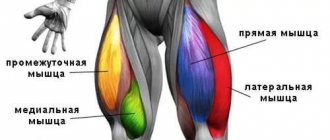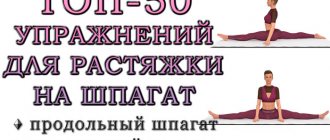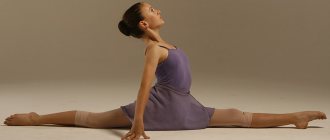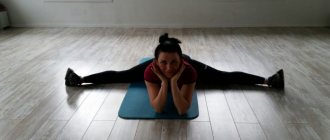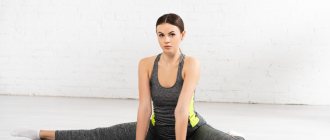Every woman dreams of being flexible, like a ballerina or gymnast. And what element in gymnastics or ballet is the concept of “good stretching” most often associated with? Of course, with twine: in terms of entertainment and benefits, it has no equal.
Showing off your excellent physical fitness, having good control of your body, becoming more confident in yourself, or simply setting a goal and achieving it - these are just some of the reasons that encourage us to do the splits. Well, as a bonus, you can increase the elasticity of ligaments and joints, and get rid of disruptions in the menstrual cycle. Your legs and abs will become more toned - because stretching exercises for the inner thighs help get rid of cellulite and belly fat. Do you think that it is quite difficult to achieve all these advantages? And you will be wrong. Any healthy woman can master the longitudinal split in a month . “ At the same time, it is important not to be lazy and supplement stretching exercises with classes in the gym or group training: only then can you achieve a positive result.” Everything is in your hands: combine our set of exercises with training - and in just a month you will be able to easily do the splits - like a gymnast or ballerina.
- It is better to do stretching exercises in the morning. According to experts at the University of Tennessee, this type of physical training improves blood circulation and performance. Also, quiet exercises are very good for those who are not in the mood for intense training immediately after waking up.
- Do the exercises smoothly, at a calm pace . Focus on your own sensations: lingering at the bottom point for 10–15 seconds, you should feel moderate muscle tension, but not pain.
- Before exercise, warm up your muscles: do squats and leg swings, rotate your feet and hips. This will help prevent stretching when moving suddenly.
- To improve the tone of your thighs, in the evening, when you take a shower, massage your legs and buttocks with a massage washcloth - massage, oddly enough, also helps achieve your cherished goal - improving the stretching of the inner thighs.
TRAINING PLAN Exercise 3-4 times a week, every other day. On other days, work out in the gym for at least 45 minutes - or attend group aerobic training. If this isn't enough exercise for you, jump rope for 10 minutes after your workout or run on the treadmill for 15 minutes.
The nuances of flexibility
If there are no contraindications (chronic diseases of the spine, musculoskeletal system and injuries), after 40 years you can do the splits and even become more flexible than you were at school! The main thing is to know several features of “age-related” stretching:
- The older you are, the longer you need to stretch. Every 10 years you live, your stretching time should increase by 7–10 minutes. That is, if at the age of 20 it is enough to perform all the exercises from our complex once, then after 30 you should repeat the first three exercises, after 40 you should repeat the entire complex twice.
- Choose moderate-intensity workouts. To keep your hip joints flexible, you need to keep the muscles of your hips, legs and buttocks toned. If you have never run, walk at a fast pace on the street (treadmill) or train on an elliptical. Well, instead of group aerobics classes, visit the pool (at least 2 times a week): it has been proven that regular training in the water tightens the muscles of the abs, thighs and buttocks no worse than intense cardio exercises with impact on the legs.
- Make stretching a healthy habit. In the morning, as soon as you open your eyes, perform a simple but very effective stretching exercise for all muscle groups: lying on your back, stretch your arms behind your head and stretch your fingers up, toes down. When you return home after work, perform any 2 stretching exercises from our complex, after warming up your muscles (walk for 5 minutes at a fast pace or do several squats)
Who needs twine and why?
Recently we watched a concert with the participation of Pugacheva in a sincere group of women. As expected, we discussed her new slimness and impeccable makeup.
As usual, some people liked it very much, others didn’t like it at all. But when she walked across the stage, everyone almost unanimously exclaimed - and she walks like an old man!
Just like that. You can lose weight fantastically, you can use modern tricks to hide your real face, but your gait...
And all because with age, joints become less flexible, and ligaments become less elastic. Moreover, the tendons shorten, hence the gait of old people - with bent knees.
So let's stretch! And the splits are also a way to demonstrate your physical fitness.
And good form always causes admiration. And sometimes envy. So be careful - your enemies, seeing your splits, may do something unpleasant.
Helpers for getting results: the “Splits in 30 days” application
For home workouts, especially for beginners, an application on a mobile device is suitable, which will help you get the correct and safe load. The “splits in 30 days” challenge involves daily workouts with detailed instructions. But, as with everything, the application has both pros and cons.
Pros:
- Shows the correct exercise technique, correctly distributing muscle groups in the program.
- It has several difficulty levels, from beginner to advanced.
- Helps track results.
Minuses:
- Daily training is not always effective, as it does not allow the muscles to fully recover.
- Ten minutes a day is not enough for quality stretching.
Android app
iOS app
All types of stretching work the same
There are at least three types of stretching, but in fact there are many more.
- Dynamic stretching
uses the maximum amplitude of muscle movement, but does not go beyond it. Stretching occurs when you move. - During static stretching,
you need to relax and freeze in a certain position for about 60 seconds, concentrating on your sensations. - Passive stretching
is a type of stretching in which a partner helps you stretch.
One of the most effective and safest is dynamic. Here the muscles work in concentric and eccentric modes, you have complete control over the movement and work within amplitudes acceptable to you. While passive stretching is considered the most traumatic and represents the use of external physical force. Using this type of stretching, you do not control the load, and the muscles work ineffectively.
Recovery for muscles. How to properly stretch after a workout
Stretching for professionals: how to get rid of tightness in different parts of the body
Classic leg stretches
- Lean forward . Standing in your normal position, spread your feet shoulder-width apart and lean forward without bending your knees. Your goal is to place your palms on the floor. This exercise perfectly stretches the tendons of the legs and back.
- " Fold ". Sit down and extend your legs straight in front of you. Begin to lean forward without bending your back. The goal is to lie with your stomach on your thighs. This very effective exercise is called the “fold.” Repeat this several times, and then freeze for a minute at the lowest point of the inclination.
- Modification "Folds" . The exercise can be modified by bending one leg at the knee or spreading your legs as wide as possible and bending alternately towards one leg and the other.
- Crunches . Sit down and spread your straight legs wide. Bend your right leg at the knee, pull your foot towards the inner surface of your left thigh. The left hand is placed on the right knee, the right hand on the back of the head. Tilt your torso to the left. Hold the bend for a few seconds. Perform 2-3 repetitions on one side, then on the other.
How to do the splits for beginners - 5 simple stretches for everyone
Before each workout, you must warm up. To do this, you can do a light jog or yoga exercises for 5-10 minutes. This is necessary to increase the intensity of blood circulation throughout the body. When body temperature is increased, mobility improves, as a result of which stretching becomes easier and more effective, and performing splits exercises without warming up is not only less effective, but also dangerous, as the risk of injury increases.
Runner's Knee Lunge
The runner's lunge is typically performed as a person prepares to perform a side split.
- Basic stance with feet together
- Step your right foot forward while simultaneously extending your left leg back
- Lower your knee toward the floor until your front knee is vertical over your foot. In this case, a stretch should be felt in the femoral flexor (thigh muscle)
- Think about driving the left hip flexor into the floor for increased effect.
- Hold for 20-30 seconds. Repeat 2-3 times on each side.
Bent Over Hamstring Stretch
To stretch your hamstrings, you need to extend your leg in front of you. This exercise will also help you get into a split position.
- From a runner's knee lunge position, extend your front leg and squat down onto your heel.
- Keep your back straight while stretching forward
- Stretch your torso toward your thigh, not toward your front toes.
- Hold for 20-30 seconds. Repeat 2-3 times on each side.
Deep lunge to the side
The side lunge exercise is essential for strengthening your quadriceps, hips, and adductor muscles, specifically the adductor longus, adductor brevis, and adductor magnus.
This exercise will strengthen the muscles of the inner thigh, which will improve control when moving into the split position.
- Basic feet together
- Step to the right and lunge to the side with your knee vertical over your foot.
- Place your left hand on the floor. With your right hand, intensively move your right knee outward. There should be a stretching sensation in the inner left thigh and right hip flexor.
- Hold for 20-30 seconds. Repeat 2-3 times on each side
Pigeon pose
I would recommend doing this stretch every day. This pose stretches the hip flexors, gluteus minimus and maximus, as well as the piriformis and psoas muscles. This is to improve control so that your hips are level.
- Get on all fours
- Extend your right knee so that your ankle is behind your left wrist. The front leg should be bent 45-90 degrees, depending on the shape of the skeleton and level of flexibility.
- Stretch your left leg back and place the top of your foot on the floor
- The right ankle should not be under the left thigh. To do this, move your left leg back even more
- Both hips should be at the same level
- Place your hands on the floor and lower yourself to your elbows or lower
- Stay in this position for 20-30 seconds. Repeat 2-3 times on each side
Leg Supported Pigeon Pose
There are many variations of pigeon pose for different levels of flexibility. This option is a little more complicated. You will feel a stronger stretch in your hip flexors.
- Assume pigeon pose with your right foot in front. Bend your leg behind you so that your toes point toward the ceiling.
- Reach back to grab your left leg with your left hand
- Pull your left leg towards your torso
- Press your left thigh to the floor if you feel a rise
- Stay in this position for 20-30 seconds. Repeat 2-3 times on each side
If you don't reach the floor with any of these exercises, use yoga blocks to correct your position.
Erin Motz, a yoga instructor with more than thirteen years of experience, says, “You should strive for proper form, and depth will come naturally with time, so don't try to do the exercises to the limit. The hips should hit at the same level. Make sure the thigh bones are positioned one behind the other."
Analyzing my mistakes, I can say that correct technique is the key to development, even if it means using blocks.
How to make longitudinal twine
After your body is warmed up and all the stretches described above have been completed, you can begin to try to do the splits. Start by doing a runner's lunge with your knee on a soft surface (I like to do this on fluffy carpet). Slowly pull your front leg away from you while holding onto the yoga blocks with both hands. Lower your hips as far as is comfortable. Keep both thighs level if you need to perform a proper split. Don't force yourself (too hard) if you don't feel comfortable. Stay in this position for 20-30 seconds, while relaxing and breathing. Also, if you put on socks it will be easier to slide.
When performing the splits, it is normal to have a “bad side” and a “good side.”
Although it is easier to perform the exercise on the “good side,” you should train both. I usually do the splits on the “bad side” first, then doing the splits on the “good side” is even easier!
For beginners, it is very useful to use auxiliary equipment. You can use books or pillows to place under your hips to support you while doing the exercise. Again, yoga blocks will help you do the splits faster—use them!

